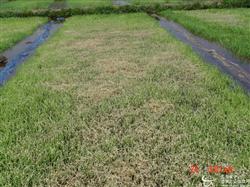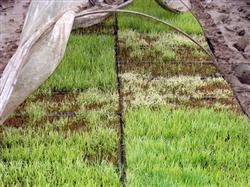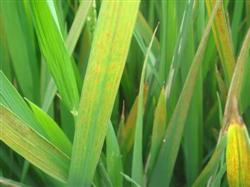Diagnosis and control of rice seedling rot

Rice seedling rot is a general term for rotten seeds, rotten buds and dead seedlings caused by pathogen infection or non-pathogen influence. It can be divided into two categories: infectious and non-infectious (physiological). Non-infectious seedling rot mainly refers to the infection caused by adverse environment; infectious seedling rot refers to the infection caused by Pythium, Fusarium, etc. induced by adverse environment. 1 symptom diagnosis 1.1 rotten seed mainly refers to the phenomenon that the embryo turns black, smelly and even rotten after rice sowing. 1.2 Bud rot refers to the phenomenon of bud and root death during germination to green transformation, which is divided into physiological rot and infectious rot. 1.2.1 Physiological rotten buds and silted seeds: seeds are sown too deeply, and the coleoptile cannot elongate and rot; exposed seeds: seeds are exposed on the soil surface, and the roots cannot be inserted into the soil and wither and dry; stilted feet: seed roots do not enter the soil and dry up; inverted buds: only buds do not grow roots and float on the water surface; fishing hook roots and buds grow poorly, and yellow brown curls appear fishhook-like; black roots: root buds are poisoned, and the seed roots and secondary roots are black and rotten. 1.2.2 Infectious bud rot: It is easy to develop under low temperature and high humidity conditions. At the beginning of the disease, white jelly is produced outside the glume at the base of roots and buds, and then woolly mycelium grows, which turns brown or greenish brown, causing the bud to brown and die. Rotting buds: start to occur sporadically, then cluster and die in pieces. At the beginning, there are water-soaked light brown spots at the base of root buds, followed by woolly white hyphae, and some white or light pink mold. The base of young buds is constricted and easy to pull off. The young roots turn brown and rot. 1.3 Dead seedlings refer to the death of seedlings after the first leaf is unfolded, mostly occurring at the 2 - 3 leaf stage. There are two types of green and yellow withered. Wilt type: heart leaves wilted tubular, lower leaves wilted and curled, seedlings dirty green and finally dead. The root color of diseased seedlings is dark and the root hairs are scarce. Yellow-withered type: starting from the lower leaves, the leaf tips gradually turn yellow to the leaf base, and then expand from the lower to the upper leaves, and finally the stem base softens and browns, and the seedlings die yellow. 2. Control methods The key to control rice seedling rot is to grasp seedling technology, improve environmental conditions, enhance disease resistance, and supplement chemical control if necessary. 2.1 Seedlings shall be raised by dry seedling cultivation and sparse planting technology or by film mulching. The seedling field shall be selected in the flat field with leeward sunny, medium fertility, convenient irrigation and high terrain. The seedling bed shall be cultivated and dried. It is recommended to apply decomposed compost or organic fertilizer to improve the microbial structure in the soil. 2.1.1 Seed selection Select clean seeds with good maturity and high purity, and dry them before soaking. 2.1.2 Soaking seeds should be soaked, the embryo part should be expanded and protruded, the husk should be translucent, and the embryo can be faintly seen through the husk. Germination should be promoted at high temperature (36~38℃), moderate temperature (28~32℃), root promotion, watering and germination at low temperature. 2.1.3 Seeding at appropriate time According to the characteristics of varieties, determine the sowing time, sowing quantity and seedling age. Sowing should be started when the daily average temperature is stable and passes 12℃. It is required to sow evenly. Try to ensure that there are 3~5 sunny days after sowing, which is conducive to rice germination. Sprinkle fine nutrient soil after sowing, keep warm and moisturize, and help seeds take root and sprout. 2.1.4 Strengthen the management of water and fertilizer, mainly root and seedling in bud stage, keep the ridge surface moist, do not add water too early, and irrigate for a short time in case of frost to protect buds. Water can be irrigated in shallow water after 1-leaf development, and in 2 - 3-leaf stage to reduce temperature difference. When the cold spell comes, irrigation can be used to protect seedlings. After the cold air, normal management can be carried out. The seedlings of film seedling are generally exposed to the air at 8:00~9:00 in the morning, and shallow water is poured before the air to prevent the sudden change of temperature and humidity. The seedling fields where dead seedlings are found are irrigated once a day with "running horse water" to dilute the poison. Fertilization should master the principle of base fertilizer stability, topdressing first small amount and then large amount. After the seedlings are fully planted, root fertilizer can be applied with clear manure water, biogas liquid or diammonium water; after the leaves are unfolded, seedling fertilizer should be applied early. 2.2 Chemical control 2.2.1 Rhizoctonia solani (1) Control with transplanting spirit mixture: transplanting spirit mixture has dual functions of plant growth regulator and fungicide, with root promotion, seedling development, anti-aging and sterilization effects, and can effectively control Rhizoctonia solani. The method of application is 1~2mL of transplanting spirit mixture and 3kg of water are sprayed on 1m2 rice seedbed. 0. 2 ~ 0. 5 mL mixture of transplanting spirit and 0. 5 kg water were used to control seedling tray (60×30cm). It can also be dissolved in water together with base fertilizer, sprayed evenly on the bed soil, then sown seeds and covered with soil film;(2) 15% Likuling control: 0.9g Likuling mixed with 1kg water for each plate of seedlings. 500-fold solution of Likuling can be sprayed on seedlings at 1 leaf and 1 heart stage, which can effectively control seedling blight. 2.2.2 Control of seedling rot caused by cotton rot fungi After finding the central diseased plant, use 800~1000 times solution of 25% metalaxyl WP or 700 times solution of 65% dixon WP. 40% Miekusan soluble powder (40% Jiadifen) was the first choice for the rotten seedlings caused by mixed infection of Fusarium oxysporum and Fusarium solanacearum. Application method: A bag of 100g Miekusan can control 40m2 or 240 seedling trays, and can also be sprayed at 1 leaf and 1 heart stage of rice seedlings. In addition, it can also be sprayed with 500~800 times of 30% Likuling wettable powder or 500~1000 times of Guangmieling aqueous solution for control, and a thin water layer should be maintained when spraying. 100~200g copper sulfate over 90% was added into the water inlet bag and irrigated into the seedling field with water flow. When the disease is serious, the seedling field should be changed to clean water 2~3 times before applying pesticide. 2.3 Double-film mulching cultivation technique can effectively solve the problem of rice seedling rot and low yield caused by low temperature, and make full use of temperature, light and water resources to create high yield.
- Prev

Common knowledge of Rice Black-streaked Dwarf Disease in South China
Rotten rice seedlings are the general name of rotten seeds, rotten buds and dead seedlings that occur in the seedling stage. Rotten rice seedlings can be divided into two types: physiology and infectivity. Physiological rotten seedlings are mainly caused by low temperature and poor management measures, infectious rotten seedlings are caused by pathogen infection, and the main diseases are rice cotton rot, rice rot and rice.
- Next

Rice seed soaking technique
Rice premature senescence refers to the premature senescence of rice leaves from heading to maturity, brown leaves, dirty white death at the top of the leaves, thin and curved leaves, weak root growth, and even a few black roots. There are many factors causing premature senescence of rice, except for diseases and insect pests, there are mainly the following.
Related
- The first cup of black tea in spring, the flavor and history of tea gardens in Kenya, Africa
- The computer can not only choose potatoes, but also grow tea rice. AI will grow winter oolong tea champion.
- It is not only the inflated tea bitten by insects, but also engraved with the four seasons tea in Beipu.
- The Oriental Beauty Tea Festival in Zhuxian County takes the stage at the weekend to experience the plus-size feast of oil tea.
- & quot; Oriental Beauty Tea & Exploration of Emei in Hsinchu, the hometown of quot;
- The new variety of strawberry "Tainong 1" dessert is the first choice with mellow aroma. Crimson gorgeous
- History of Tea in Taiwan: from Wild Inner Mountain to Export Tea Garden
- Two types of Taiwan Oriental Beauty Black Tea won the British three-Star Award for Childhood Tea Xiang Zhang Jiaqi changed from pilot to champion tea maker.
- Banana species and varieties: the planting history of Taiwan Xianren banana and dwarf banana is long, is banana disease resistant?
- Coffee planting Technology: Qianjie Coffee from Seedling to harvesting

